Little Gallery
on Fessenden
Celebrating Creativity
in the Neighborhood
Current Exhibits
Sakura and Maquilishuat: Two sisters in bloom
Mauricio Chavarria Iglesias (Dad), Anabell Iglesias Chavarría (Mom) and 10-year-old Andrés (Son)
The Maquilishuat Tree (Tabebuia Rosa) was declared the National Tree of El Salvador in 1939. Diplomatic relations between El Salvador and Japan had started 4 years previously, on February 15, 1935. After WWII, in 1955 El Salvador was one of the first Western countries to open its market to Japanese products, and stories such as El Salvador becoming the second importer of Toyota vehicles globally (the first being Taiwan), are still told today. Likewise, El Salvador became the first Latin American Country with direct Japanese investment when a textile factory was established due to a strong cotton industry.
Culturally, the ties in the country have continued with El Salvador again being the first Latin American country to welcome in 1968 volunteers from Japan Overseas Cooperation Volunteers (JOCV) and receiving cooperation in socioeconomic development.
The Sakura-Maquilishuat Project was started by the Embassy of Japan in El Salvador to raise awareness on environmental issues, and the name showcases the similarities between both national trees. Sakuras bloom in the Springtime, their pink flowers capturing Japanese whimsy in that nation and drawing both locals and tourists as well around the Tidal Basin in Washington DC. Maquilishuat trees bloom in February, a contrast as it is dry season in El Salvador. The pink blooms of Maquilishuat are striking against valleys, hills, and mountains that largely look brown.
Commemorating 70 years of diplomatic relations and friendship between nations, in 2005 the Embassy of Japan in El Salvador plants a tree for every project developed in the country as part of their assistance programs to communities.
The ties to Japan continue in our exhibiting family. Anabell (mom) fell in love with Japan when she was a young girl and later studied Asian Studies at Sophia University inTokyo, Japan in 2006. Mauricio (dad) has family in Japan, after a young Japanese student traveling the world stopped in El Salvador and fell in love with a young girl across the street from where he was staying. 30 years later, their youngest son came back to El Salvador and established one of the first surf-side hostels at surf-acclaimed El Zonte beach. Andres (son) famously requested a pizza and origami party when selected for a special party during 3rd grade. Thankfully, the amazing Mrs. Boldrick quickly learned how to create origami and saved the day.
To all exhibit visitors: Thank you! // Arigato gozaimasu! // Gracias!
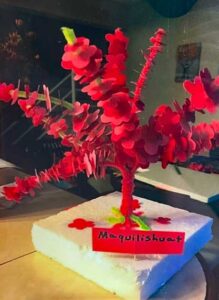
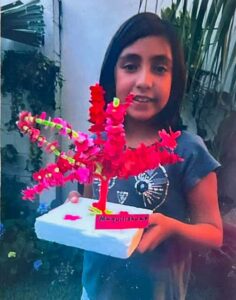

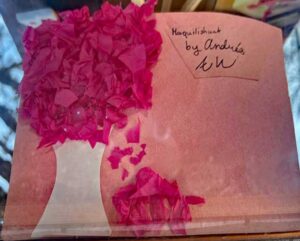
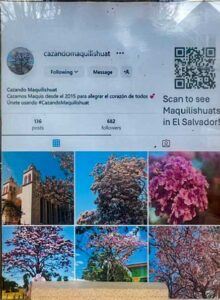

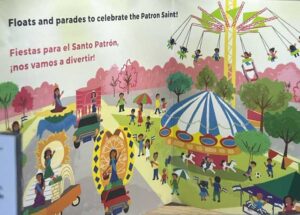
Top Gallery:
- The Maquilishuat Tree is always a part the backdrop in El Salvador, as seen in this children’s book – selection from our library.
- A post from the Embassy of Japan in El Salvador, showcasing Sakura and Maquilishuat and the planting of trees in each project.
- The @cazandomaquilishuat Instagram account has pictures of Maquilishuats around El Salvador.
- Our tribute to Stumpy via a picture taken by Mauricio in 2022 and first shown at The Little Gallery later that year.
Bottom Gallery:
Children create Maquilishuat crafts since a young age. Pictures is Daniella with her Maquilishuat craft tree and a recent one made for the exhibit by Anabell and Andres.
Audio Gallery:
From Anabell’s pen:
To Maquilishuat, from Sakura- A haiku
Little Gallery is looking for visual and audio exhibitors
Who knew that there were so many shy people out there?
If you are proud of a painting, drawing, song, poem, very short story, or comedy routine that you’ve created, why not share it with our supportive community? Anything, so long as it’s in good taste, is acceptable.
Don’t be shy! Email sid@littlegallery.org to sign up.